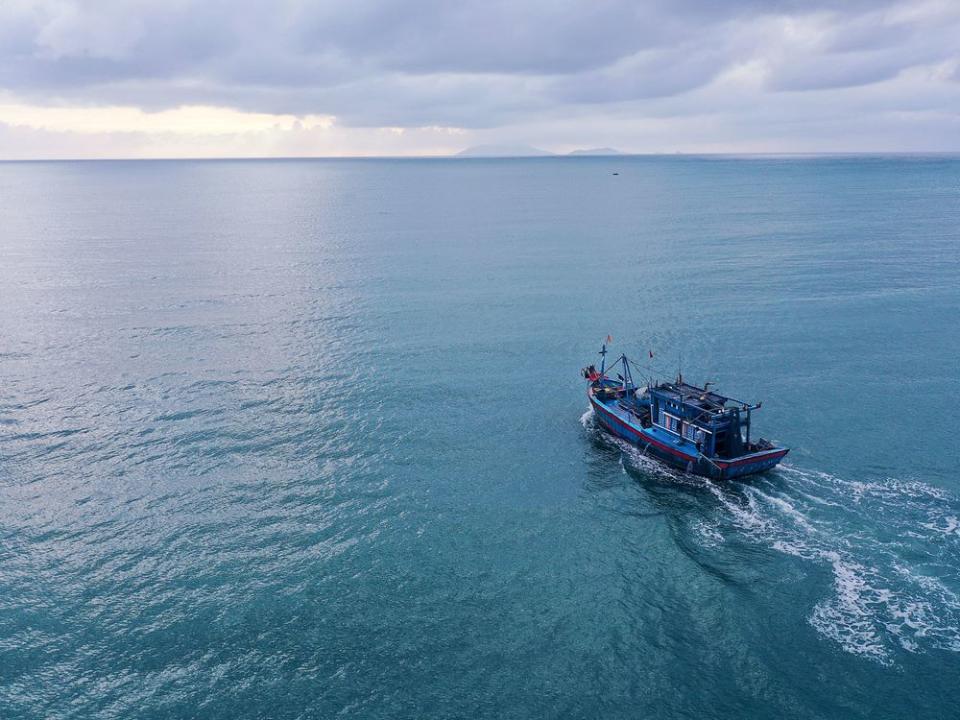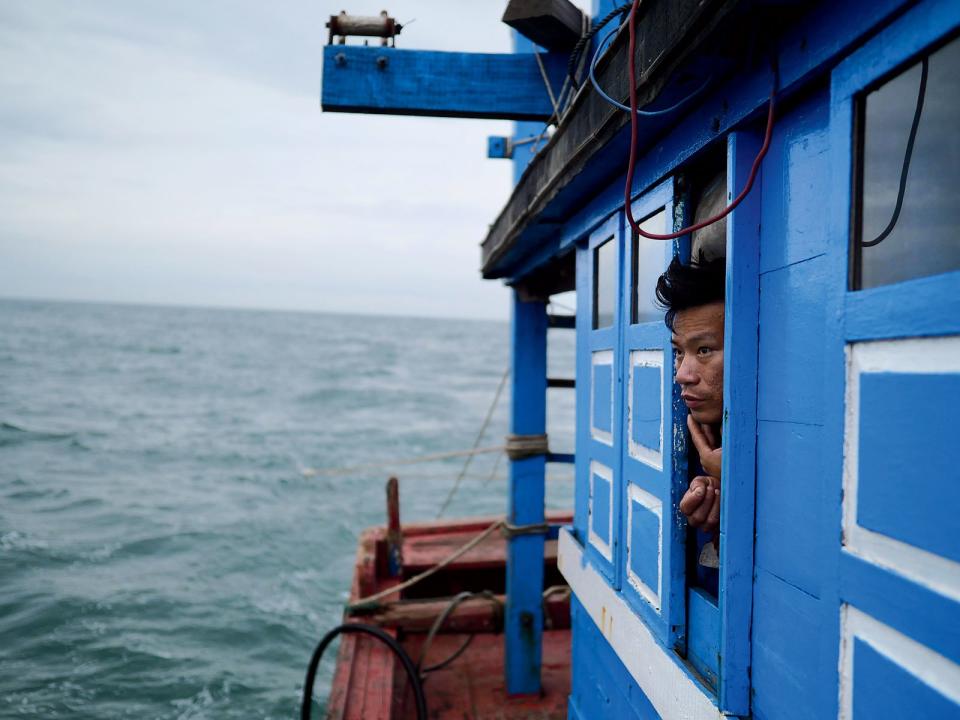Vietnam's Snail Restaurants Are Worth Traveling For
It's a Saturday night in Ho Chi Minh City, Vietnam, and I’m at my dream restaurant, Oc Oanh. Under a broad awning that stretches across the sidewalk, my friends and I sit on blue plastic chairs at a low metal table, sipping mugs of Saigon beer on ice while around us swirls a carefully choreographed chaos. A grill sends fragrant smoke into the air. Customers loudly toast one another: mot, hai, ba, vo! (one, two, three, cheers!) Waiters clear tables by dumping meal remnants on the floor to be swept up later. Mopeds and SUVs honk in the warm drizzle beyond the awning. It’s a glorious mess, made all the more glorious by the food: grilled octopus with creamy green chile sauce, clams steamed in spicy lemongrass broth, scallops grilled in their shells with scallions and peanuts, and—most important of all—snails. Sea snails and freshwater snails, tiny snails and big snails and hulking conch, fried with garlic, or butter, or coconut milk, or chiles and salt. Snails, snails, snails!
And Oc Oanh is just one of hundreds, maybe thousands, of quan oc—snail restaurants—across Vietnam. The concept is simple: a casual place you go with friends to chat, drink, and eat not just snails (oc) but every other kind of mollusk and crustacean found along this nation’s 2,000-plus miles of coastline. You pick your seafood, pick your cooking style (grilled, steamed, raw, stir-fried), then order more. After visiting Vietnam for more than 20 years, I’ve grown obsessed with snail restaurants—with the complex flavors and easy socializing, sure, but also with the transformation of shellfish into a rough-and-ready snack food. It’s only on a recent, snail-focused visit, however, that I began asking local friends how quan oc arose.
“Let’s not make this complicated,” explains Peter Cuong Franklin, chef at Anan Saigon, which serves quirky, ambitious dishes like a $100 banh mi (truffle mayo, sous vide pork chop, and foie gras). “They have a lot of seafood. They like to nhau.”

Nhau is a major part of Vietnamese culture. Basically, it means “drinking while eating”—like post-work wings and beer, but more intense. Snails are an ideal food for nhau, Franklin says, because prying them from their shells—with a small fork or toothpick—takes time and effort, meaning you hang out longer, drink more, talk more, have more fun. It’s practically algebraic.
At Anan (which means “eat eat”) and its upstairs pho bar, NhauNhau, Franklin gets into the oc racket a few ways, like simmering mussels with artichokes in lemongrass broth, or using them to top a rice-paper pizza along with mozzarella, scamorza, and rau ram, a peppery herb also known as Vietnamese coriander. It’s Napa Valley meets the Mekong Delta.
Snail restaurants are popular everywhere here, but when I think about seafood, I think about, well, the sea. That’s why I head 600 miles north to Da Nang, which some describe as “the Miami of Vietnam.” It’s one of the country’s largest cities (population 1 million), and it does resemble Miami geographically, with a long north-south beach-and-resort area separated from the urban center by a multi-bridged body of water. Even the architecture is reminiscent of mod South Florida, with crisp angles and sharp hues that stand out against the open sky.
This isn’t just Ho Chi Minh City with sand, though. The pace of life is relaxed, and the snail restaurant approach, too, is slightly different. Rau ram, copious and essential down south, is merely optional in Da Nang, its place taken by Thai basil. There are fewer snail species, perhaps, but there are other sea creatures such as an oval-shaped clam called chip chip. What doesn’t change is the sense of casual, raucous fun. The nhau ethic is alive and well at places like Oc Ha, a streetside stall where my friends and I slurp spicy oc len—obtuse horn shell, in English—in coconut milk.

At Hai San Ba Cuong, a big beachside restaurant owned by a seafood distributor, I strike gold: The chef, Hong Tran, is willing to demonstrate for me some of the recipes I’ve come to adore. In fact, they’re easy. The addictive spicy brininess of grilled shrimp comes from a glaze of fish sauce, chile paste, and sugar. To stir-fry oc huong (a speckle-shelled snail also known as Babylonia areolata), I need “shrimp salt,” a ground mix of dried shrimp, salt, chiles, and other ingredients that is basically Vietnamese umami (and sold in jars). I even get an aha moment when Tran makes grilled pen shell with a classic scallion-peanut-shallot topping that, it turns out, is bound by oyster sauce. I can make this at home, I realize, with mussels or clams.
Even at Nen, a high-end restaurant started by food blogger and chef Summer Le, the recipes are within reach. To make mantis shrimp, Le simply poaches and carefully shells them, then sets them in a bowl of clam broth and coconut juice with a drizzle of curaçao that turns the soup lagoon-blue. Her take on tamarind crab, another snail-restaurant standard, substitutes soft-shell crab for hard-shell, sauced with a mix of tamarind, lemongrass, ketchup, chicken bouillon powder, and nen, a pea-size garlic-shallot hybrid that’s a Da Nang specialty. Of course, Le plates it beautifully at her restaurant (with lime foam!), but I’d be happy sliding it into a baguette for a beach-picnic banh mi.
The most important snail lesson I learn in Da Nang, however, is not at a restaurant. It’s on a boat—a crusty fishing trawler where I spend an overnight shift with fishermen Cuong, Loc, and Binh as they circle the bay, pausing every couple hours to haul in their net and sort through the results: fish and shrimp large and small, a rainbow of crabs, and lots of snails, some the size of lacrosse balls, others long and corkscrew-y. Then they toss the net back out and tool around some more.
Around 2 a.m., they summon me to the stern, where they’ve boiled up a portion of the night’s catch in plain water. We sit there in the dark, plucking meat from mantis shrimp and cracked crabs and weird snails, dipping them into a bowl of salt and chiles. It’s all buttery and salty and sweet and spicy, free of technique, the flavor based purely on freshness. It may be the best seafood I’ve ever had, and I can understand why these guys do this tough job with its impossible hours. The only thing missing, I realize, is beer.

Da Nang at a Snail's Pace
Fly
There are no nonstop flights to Vietnam from North America, but nearly every airline has connections to Ho Chi Minh City or Da Nang through Asian hubs such as Hong Kong, Tokyo, Beijing, Taipei, and Seoul. Tourist visas are required for U.S. citizens.
Stay
In addition to its captivating location on Ha My Beach and its one- to five-bedroom villas inspired by traditional Vietnamese garden homes, Four Seasons The Nam Hai in Hoi An, south of Da Nang, offers a range of culinary experiences, including immersive trips to nearby fishing villages and cooking courses. (Doubles from $725; fourseasons.com/hoian)
Eat
Across the street from the beach, Hai San Ba Cuong (Nga 3 Hoang Sa) serves Vietnamese seafood classics, like grilled shrimp with salt and chiles, pen shell with scallions and peanuts, and a zillion types of crab. In the city, Oc Ha (294 Ong Ich Khiem) serves snails right at tables set out on the sidewalk—the snails cooked in coconut milk and the shredded young-jackfruit salad are musts. For a more refined experience, at Nen Restaurant (restaurant nen.com), chef Summer Le prepares ambitious tasting menus featuring dishes such as tamarind soft-shell crab, dry-aged chicken with kumquat sauce, and steamed squid with ginger sauce and mango mousse.
Swim
Backed by a ribbon of evergreen trees, the pale, powdery sands of My Khe Beach were a favorite among U.S. soldiers, who called it China Beach, during the Vietnam War. A couple miles east of Da Nang’s city center, the shoreline runs for about six miles along the South China Sea and holds a colorful collection of seafood restaurants and vendors. South of My Khe, Non Nuoc Beach stretches for another three tranquil miles at the foot of the picturesque and historic Marble Mountains. On Da Nang Bay, north of the city, Nam O is a humble beach with a culinary brag: vendors serving goi ca, marinated and spiced raw fish fillets served in rice-paper rolls with fish sauce.


